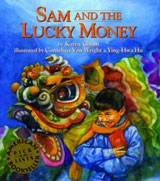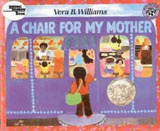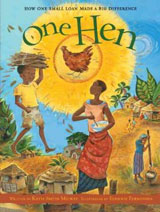[This is the latest in an occasional series by Beth Melo, a Southborough mom who loves to read to her kids. This post was originally published on the Southborough Library website, and has been reposted here with permission. For more of Beth’s book recommendations, click here.]
 Please, May I Have Some More? (I opened those presents. Where are the rest?)
Please, May I Have Some More? (I opened those presents. Where are the rest?)
This time of year, we talk a lot to our children about appreciation. We spent November asking them to be grateful for what they have. Many of us spend December trying to tell them it is better to give than receive. Yet, most children in our town are fortunate enough to not really understand.
Members of our community who struggle financially often cloak their hardships behind proud facades and confidential assistance. Children tune out lecturing words and don’t see neighbors’ struggles. So, they are more likely to notice friends who have more, not less. They see what they want and don’t have. And the third world is foreign in every respect. So how can we expect them to grateful?
As a parent, I try find ways to expose my children to hardship in the world without overwhelming them. In my quest, here are the books that I found that seem to fit the bill. They are a starting point for conversations. And they have helped to expand their view of the world around them.
 Close to Home – These stories help put in context how lucky we are compared to others in our community or nation:
Close to Home – These stories help put in context how lucky we are compared to others in our community or nation:
- Vera Williams’ A Chair for My Mother ,Something Special for Me, and Music, Music for Everyone. This trilogy of picture books are narrated by a girl whose family is used to living on very little and making the best of it. In the first story, the family saves up coins until they have enough to afford a comfortable chair for her mother to sit in at the end of a hard day of work. In the second book, where she gets a chance to buy something for herself, she understands the value of the money being spent. This prompts her to be very careful about her choice.
- Sam and the Lucky Money by Karen Chinn tells the story of a boy who receives a few dollars for Chinese New Years. When he goes to spend it, he realizes how little it will buy him. But when he encounters a barefoot homeless man, he realizes that what seems so little to him, makes a difference to someone else.
- Love, Lizzie by Lisa Tucker McElroy is told through the letters of a girl writing to her mother, who is serving the military overseas. This is a great way to talk about how the people who serve our country and their families make sacrifices to keep us safe.
- Uncle Willie and the Soup Kitchen by DyAnne DiSalvo is about a boy who’s uncle works at a soup kitchen and brings him to help one day. It explains need and charity without sentimentality.
- The Ring and the Window Seat by Amy Hest tells the story of a girl who saves money all year to buy herself a ring. But when she meets a man who is trying to save enough money to bring his daughter safely to this country, she gives it to him.
 Global View – When we talk about how difficult life was for the pilgrims, we explain that they didn’t have the resources we have now. We often forget to mention that there are places in the world where people still have to make do with very little. Here are some good stories about life in the third world and war-torn regions:
Global View – When we talk about how difficult life was for the pilgrims, we explain that they didn’t have the resources we have now. We often forget to mention that there are places in the world where people still have to make do with very little. Here are some good stories about life in the third world and war-torn regions:
- Beatrice’s Goat by Page McBrier
- Four Feet, Two Sandals by Karen Lynn Williams
- Mama Panya’s Pancakes by Mary Chamberlin
- One Hen: How One Small Loan Made a Difference by Katie Smith Milway
The downside of this endeavor is you can prompt an imperfect charitable impulse in your children. My daughter now wants to give a family a farm animal for Christmas. But, she doesn’t want to actually sacrifice any of her gifts to do this. (She says she does, but her Christmas wish list tells a different story.) Still, being charitable has to start somewhere and this is a pretty good place to start.
As always, if you have any questions for me, feel free to e-mail becmelo@yahoo.com. If you have any additional suggestions for other parents, you can post a comment below.

